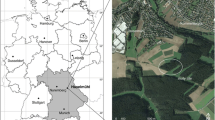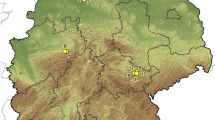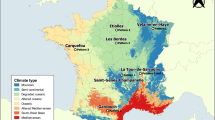Abstract
The seasonal weather-driven activity of the tick Ixodes ricinus is frequently explored using multisite surveys. This study aimed to investigate the statistical modeling of seasonal trends in the activity of I. ricinus nymphs when both the influence of abiotic factors and spatial heterogeneity were taken into account. Time series data of abiotic covariates (temperature, relative humidity, rainfall and photoperiod) and nymphal tick counts were recorded on several sites in The Netherlands, Belgium and in France in 2008 and 2009. The sites were divided into two subsets which were used for model construction or model validation. A generalized linear mixed model was set up, with aggregated abiotic covariates as fixed effects, and the collection site as a random effect to account for the site-varying density in nymphs. A linear regression model was developed to estimate the site effect against the observed local abundance on each site. The activity patterns simulated from the weather and photoperiod covariates realistically reproduced the observed seasonal trends in nymphal tick activity. The fit between observed and simulated nymphal count time series was greatly improved when the site-specific local abundance in nymphs was included. Our modeling approach allows indicators of local tick abundance and the temporal modeling of I. ricinus activity to be combined. The model presented here can also be used to study scenarios on the temporal patterns of I. ricinus activity in the present and in the context of climate change.





Similar content being viewed by others
References
Acevedo P, Ferreres J, Jaroso R et al (2010) Estimating roe deer abundance from pellet group counts in Spain: an assessment of methods suitable for Mediterranean woodlands. Ecol Indic 10:1226–1230. doi:10.1016/j.ecolind.2010.04.006
Barandika JF, Berriatua E, Barral M et al (2006) Risk factors associated with ixodid tick species distributions in the Basque region in Spain. Med Vet Entomol 20:177–188. doi:10.1111/j.1365-2915.2006.00619.x
Barros VR, Field CB, Dokken DJ, et al (2014) Climate change 2014: impacts, adaptation, and vulnerability. Part b: regional aspects. In: Intergovernmental panel on climate change, contribution of working group ii to the fifth assessment Report. Cambridge University Press, Cambridge, p 688
Bates D, Mächler M, Bolker B, Walker S (2015) lme4: linear mixed-effects models using eigen and S4. http://CRAN.R-project.org/package=lme4
Belozerov V, Fourie L, Kok D (2002) photoperiodic control of developmental diapause in nymphs of prostriate ixodid ticks (Acari: Ixodidae). Exp Appl Acarol 28:163–168
Beugnet F, Marié J-L (2009) Emerging arthropod-borne diseases of companion animals in Europe. Vet Parasitol 163:298–305. doi:10.1016/j.vetpar.2009.03.028
Beugnet F, Chalvet-Monfray K, Loukos H (2009) FleaTickRisk: a meteorological model developed to monitor and predict the activity and density of three tick species and the cat flea in Europe. Geospat Health 4:97–113
Boyard C, Barnouin J, Bord S et al (2011) Reproducibility of local environmental factors for the abundance of questing Ixodes ricinus nymphs on pastures. Ticks Tick Borne Dis 2:104–110. doi:10.1016/j.ttbdis.2011.02.001
Campbell JA (1948) The life history and development of the sheep tick, Ixodes ricinus L., in Scotland under natural and controlled conditions. University of Edinburgh, Edinburgh
Cat J, Chalvet-Monfray K, Halos L, et al (2015) Improving the TickRisk model: a tool to integrate environmental determinants in the prediction of the activity of ticks in Europe
Curriero FC, Shone SM, Glass GE (2005) Cross correlation maps: a tool for visualizing and modeling time lagged associations. Vector Borne Zoonotic Dis 5:267–275
Daniel M, Cerny V, Dusbabek F et al (1976) Influence of microclimate on the life cycle of the common tick Ixodes ricinus (L.) in thermophilic oak forest. Folia Parasitol (Praha) 23:327–342
Daniel M, Malý M, Danielová V et al (2015) Abiotic predictors and annual seasonal dynamics of Ixodes ricinus, the major disease vector of Central Europe. Parasit Vectors. doi:10.1186/s13071-015-1092-y
Dautel H, Dippela C, Kaemmer D et al (2008) Winter activity of Ixodes ricinus in a Berlin forest. Int J Med Microbiol 298:50–54. doi:10.1016/j.ijmm.2008.01.010
Delignette-Muller ML, Dutang C (2015) fitdistrplus: an R package for fitting distributions. J Stat Softw 64:1–34
Dobson ADM, Finnie TJR, Randolph SE (2011) A modified matrix model to describe the seasonal population ecology of the European tick Ixodes ricinus. J Appl Ecol 48:1017–1028. doi:10.1111/j.1365-2664.2011.02003.x
Estrada-Peña A (2006) Prediction of habitat suitability for ticks. Ann NY Acad Sci 1078:275–284. doi:10.1196/annals.1374.052
Estrada-Peña A, Farkas R, Jaenson TG, et al (2010) Scientific opinion on geographic distribution of tick-borne infections and their vectors in Europe and the other regions of the Mediterranean Basin: EFSA Panel on Animal Health and Welfare (AHAW)
Gardiner WP, Gray JS (1986) A computer simulation of the effects of specific environmental factors on the development of the sheep tick Ixodes ricinus L. Vet Parasitol 19:133–144
Gilbert L (2010) Altitudinal patterns of tick and host abundance: a potential role for climate change in regulating tick-borne diseases? Oecologia 162:217–225. doi:10.1007/s00442-009-1430-x
Gilbert L, Maffey GL, Ramsay SL, Hester AJ (2012) The effect of deer management on the abundance of Ixodes ricinus in Scotland. Ecol Appl 22:658–667
Gray JS, Dautel H, Estrada-Pena A, et al (2009) Effects of climate change on ticks and tick-borne diseases in Europe. Interdiscip Perspect Infect Dis 2009:593232–Article ID 593232. doi: 10.1155/2009/593232
Hoch T, Monnet Y, Agoulon A (2010) Influence of host migration between woodland and pasture on the population dynamics of the tick Ixodes ricinus: a modelling approach. Ecol Model 221:1798–1806. doi:10.1016/j.ecolmodel.2010.04.008
Irwin PJ (2014) It shouldn’t happen to a dog … or a veterinarian: clinical paradigms for canine vector-borne diseases. Trends Parasitol 30:104–112. doi:10.1016/j.pt.2013.12.001
James MC, Bowman AS, Forbes KJ et al (2013) Environmental determinants of Ixodes ricinus ticks and the incidence of Borrelia burgdorferi sensu lato, the agent of Lyme borreliosis, in Scotland. Parasitology 140:237–246. doi:10.1017/S003118201200145X
Jongejan F, Uilenberg G (2004) The global importance of ticks. Parasitology 129:S3–S14. doi:10.1017/S0031182004005967
Kiewra D, Kryza M, Szymanowski M (2014) Influence of selected meteorological variables on the questing activity of Ixodes ricinus ticks in Lower Silesia, SW Poland. J Vector Ecol 39:138–145
Lees AD (1946) The water balance in Ixodes ricinus L. and certain other species of ticks. Parasitology 37:1–20
Milne A (1950) The ecology of the sheep tick, Ixodes ricinus L.; microhabitat economy of the adult tick. Parasitology 40:14–34
Ogden NH, Bigras-Poulin M, O’Callaghan CJ et al (2005) A dynamic population model to investigate effects of climate on geographic range and seasonality of the tick Ixodes scapularis. Int J Parasitol 35:375–389. doi:10.1016/j.ijpara.2004.12.013
Ostfeld RS, Canham CD, Oggenfuss K et al (2006) Climate, deer, rodents, and acorns as determinants of variation in Lyme-disease risk. PLoS Biol 4:1058–1068. doi:10.1371/journal.pbio.0040145
Perret JL, Guigoz E, Rais O, Gern L (2000) Influence of saturation deficit and temperature on Ixodes ricinus tick questing activity in a Lyme borreliosis-endemic area (Switzerland). Parasitol Res 86:554–557
Perret J-L, Guerin PM, Diehl PA et al (2003) Darkness induces mobility, and saturation deficit limits questing duration, in the tick Ixodes ricinus. J Exp Biol 206:1809–1815. doi:10.1242/jeb.00345
Perret JL, Rais O, Gern L (2004) Influence of climate on the proportion of ixodes ricinus nymphs and adults questing in a tick population. J Med Entomol 41:361–365
Pugliese A, Rosà R (2008) Effect of host populations on the intensity of ticks and the prevalence of tick-borne pathogens: how to interpret the results of deer exclosure experiments. Parasitology 135:1531. doi:10.1017/S003118200800036X
Qviller L, Grøva L, Viljugrein H et al (2014) Temporal pattern of questing tick Ixodes ricinus density at differing elevations in the coastal region of western Norway. Parasit Vectors 7:179. doi:10.1186/1756-3305-7-179
R Development Core Team (2008) R: a language and environment for statistical computing. http://www.R-project.org/
Randolph SE, Green RM, Hoodless AN, Peacey MF (2002) An empirical quantitative framework for the seasonal population dynamics of the tick Ixodes ricinus. Int J Parasitol 32:979–989
Schulz M, Mahling M, Pfister K (2014) Abundance and seasonal activity of questing Ixodes ricinus ticks in their natural habitats in southern Germany in 2011. J Vector Ecol 39:56–65
Swart A, Ibañez-Justicia A, Buijs J et al (2014) Predicting tick presence by environmental risk mapping. Front Public Health. doi:10.3389/fpubh.2014.00238
Tagliapietra V, Rosa R, Arnoldi D et al (2011) Saturation deficit and deer density affect questing activity and local abundance of Ixodes ricinus (Acari, Ixodidae) in Italy. Vet Parasitol 183:114–124. doi:10.1016/j.vetpar.2011.07.022
Vassallo M, Paul REL, Perez-Eid C (2000) Temporal distribution of the annual nymphal stock of Ixodes ricinus ticks. Exp Appl Acarol 24:941–949. doi:10.1023/A:1010669003887
Walker AR (2001) Age structure of a population of Ixodes ricinus (Acari: Ixodidae) in relation to its seasonal questing. Bull Entomol Res 91:69–78
Walker AR, Alberdi MP, Urquhart KA, Rose H (2001) Risk factors in habitats of the tick Ixodes ricinus influencing human exposure to Ehrlichia phagocytophila bacteria. Med Vet Entomol 15:40–49. doi:10.1046/j.1365-2915.2001.00271.x
Wolff JO (1996) Population fluctuations of mast-eating rodents are correlated with production of acorns. J Mammal 77:850–856
Acknowledgements
This work was supported by (1) the Adaptation of Agriculture and Forests to Climate Change (AAFCC) metaprogramme of the French National Institute for Agricultural Research (INRA), and (2) Merial, a Sanofi company. Thanks to Michel Kolasinski from the company, Climpact-Metnext, who provided the weather time series. We are grateful to Dr. Bernard Davoust from the French Army Health Services (France), Prof Edwin Claerebout from the Parasitology Department in Ghent Veterinary Faculty (Belgium) and Prof Bertrand Losson from the Parasitology Department in Liège Veterinary Faculty (Belgium) who supervised the field campaigns.
Author information
Authors and Affiliations
Corresponding author
Ethics declarations
Conflict of interest
The authors declare that they have no competing interests.
Electronic supplementary material
Below is the link to the electronic supplementary material.
Rights and permissions
About this article
Cite this article
Cat, J., Beugnet, F., Hoch, T. et al. Influence of the spatial heterogeneity in tick abundance in the modeling of the seasonal activity of Ixodes ricinus nymphs in Western Europe. Exp Appl Acarol 71, 115–130 (2017). https://doi.org/10.1007/s10493-016-0099-1
Received:
Accepted:
Published:
Issue Date:
DOI: https://doi.org/10.1007/s10493-016-0099-1




